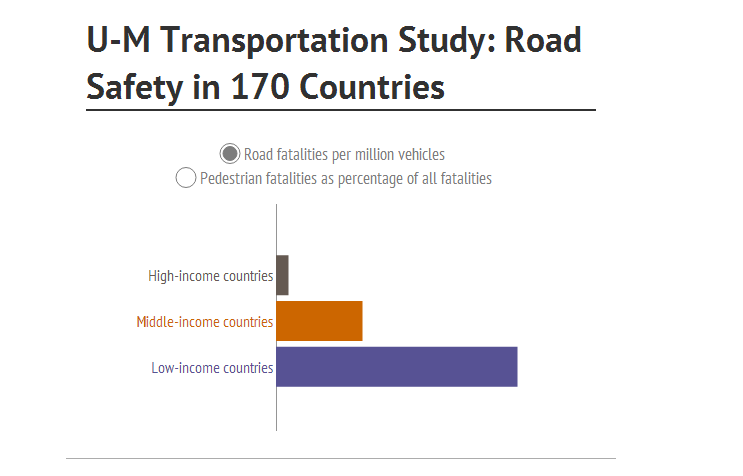Wealthier nations have lower roadway fatality rates, according to new research from the University of Michigan’s Transportation Research Institute (UMTRI). The study examined road safety in 170 low-, middle- and high-income countries, looking at both the wealth of the country and the number of roadway fatalities.
Research Professor Michael Sivak and Project Manager Brandon Schoettle at UMTRI, publishers of the report, found that the average fatality rate per million vehicles is 313 in high-income countries, 2,165 in middle-income countries and 6,040 in low-income countries.
Pedestrians are also safer in wealthier countries. The average percentage of pedestrian deaths out of all roadway fatalities is 21% in high-income nations compared with 31% in middle-income and 35%in low-income countries.
Using data from the World Health Organisation on countries with populations of at least 100,000, Sivak and Schoettle examined differences in road safety based on gross national income per person: high (more than US$12,275), middle (US $1,006 to US $12,275) and low (less than US$1,006).
The results indicate that low-income countries are less likely to have national road-safety strategies; standard vehicle regulations; laws on the installation of safety belts, airbags and electronic stability controls; laws on the use of safety belts, child restraints, motorcycle helmets and mobile phones; strict driver penalty systems; effective drunk driving enforcement measures; universal emergency access phone numbers; and policies to promote walking, cycling and public transport.
“The goal was to identify relevant commonalities that may assist in the creation of road-safety policies common to countries at a similar level of development,” Sivak said.
The results indicate that the fatality rate per vehicle decreases as income level increases, while the fatality rate per person is an inverted U-shaped function of income level.
The percentage of pedestrian fatalities out of all fatalities decreases as income level increases. Income-level effects were also found for 31 aspects related to institutional framework, safer roads and mobility, safer vehicles, safer road users, and post-crash care.
Interestingly, maximum speed limits on rural roads and near schools tend to be lower in low-income countries, but the effectiveness of speed-limit enforcement is higher in high-income countries.
The study used original data from a previous report by the World Health Organisation, which published an assessment of road safety in individual countries of the world. The UMTRI study focused on differences based on the level of development to identify relevant commonalities that may assist in the creation of road-safety policies common to countries at a similar level of development. It divided the countries into three groups, according to the level of gross national income per capita, focusing on the differences in income level both in motor-vehicle fatality rates and in a variety of factors associated with road safety.
Rachel Boagey


